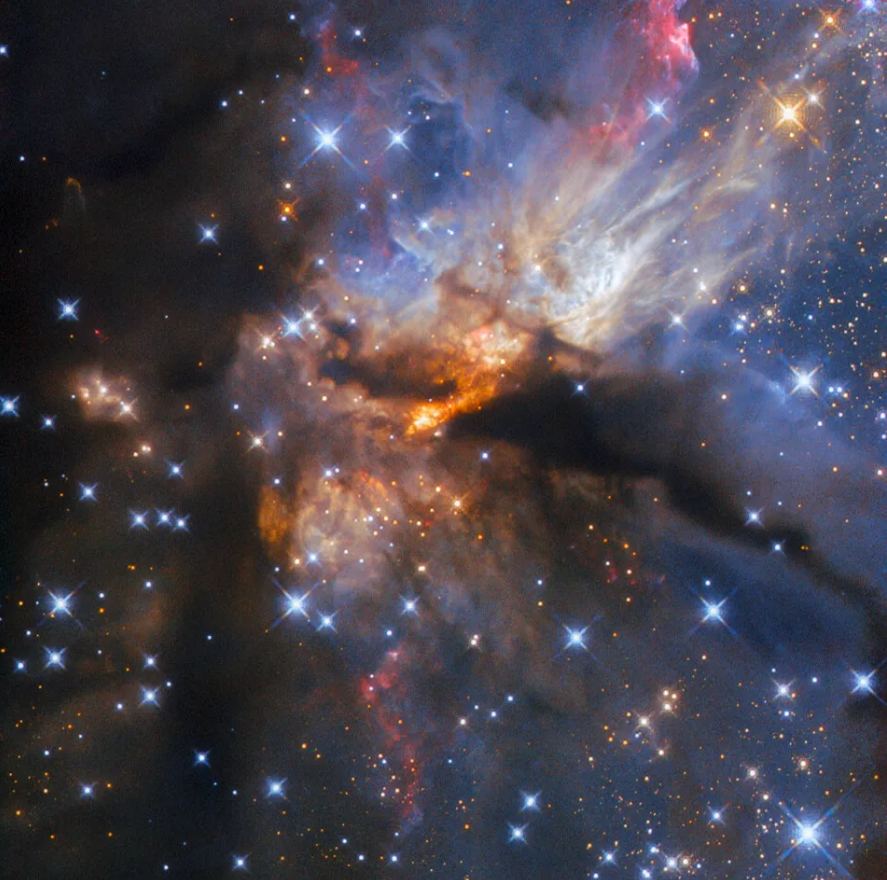The birth of a star is a spectacular event that plays out behind a veil of gas and dust. It’s a detailed process that takes millions of years to play out. Once a star leaves its protostar stage behind and begins its life of fusion, the star’s powerful radiative output blows the veil away.
But before then, astrophysicists are at a disadvantage.
Astrophysicists are keen to observe star formation in more detail so they can fill in the gaps in their knowledge. This puts star forming regions in the spotlight. But some star forming regions are hotbeds of massive star formation, and they garner even more interest because many of these stars will eventually explode as supernovae. What’s different about these regions? Why do they spawn so many massive stars? How can we watch them form inside their veils of gas and dust?
Fortunately, massive stars are energetic monsters and they can’t help but leave clues.
Astronomers have been watching a region named G35.2-0.7N, which lies around 7,200 light-years from Earth in the constellation Aquila. Over the years, they’ve used multiple telescopes to probe the region. The Hubble Space Telescope has been watching, too, and this recent image of G35.2-0.7N (G35) was the ESA’s picture of the week. The Hubble captured it with its Wide Field Camera 3 (WFC3.)
B-Type stars are the second most massive type of star, and one of them sits within this image. We can tell it’s there because it’s launching a massive jet in our direction, lighting up the region and generating this captivating image. The B-Type protostar’s jets are collimated, meaning that they’re parallel. As a result, they don’t spread out much and extend a great distance in straight lines.
This image wasn’t taken just for us to gaze it. It has a scientific purpose. One of the things astrophsyicists study to learn more about the young massive star is the jet and its ionization. The star and its jets are an extremely high-energy environment. The powerful energy from the star ionizes the gas in the jets, stripping electrons away from atoms and molecules as it propels them into space.
These protostellar jets play a role in star formation, but the details aren’t clear. The type of star behind it all is sometimes called a ZAMS star, for zero-age main sequence. It’ll eventually be on the main sequence, but for now the young star is still forming and acquiring mass, yet its blasting some of it back out into space.
Astronomers have struggled to study these outflows because massive stars typically form in groups. And most of them are far away, compounding the difficulty. It makes it difficult to interpret the observations and detect their sources accurately. Only 20 years ago, scientists were uncertain if high-mass outflows were driven by collimated jets. A 2003 paper observed that “… the majority of massive YSOs do not show evidence for jets.”

Researchers have made progress since then, and the picture has become clearer. While outflows from smaller stars are typically driven by magnetic forces, outflows from luminous B-Type stars are driven energetically. However, the magnetic fields still influences how the matter flows and determines much of what we can see.
Massive stars like these are important not only because they eventually explode as supernovae. They’re also important nucleosynthesis sites where heavier elements are fused together from lighter elements. They also drive galaxy evolution with the powerful energy and outflows the inject into the interstellar medium. On top of that, they influence the formation of low-mass stars in their vicinity.
It’s obvious why scientists want to study them, and this picture helps display why.

The massive B-type star in this image is near the center of this dark nebula. Much of the region is obscured, but the star itself is carving out a cavity near the center. It’s the bright orange region in the center of the image. The powerful jet is the small bright orange streak travelling towards us travels toward us. The jet is carving a hole in the obscuring shroud of gas and dust, revealing the massive protostar forming in the cavity. It can’t eliminate all of the dust, and what remains reddens the light to an orange reminiscent of fire. At the very lower left of the cavity is where the star is forming.
Whatever the science behind this image is, you can’t help but look at it and think nature is a show-off. It’s a stunning example of the interplay between matter and energy, the very foundation of the Universe.

